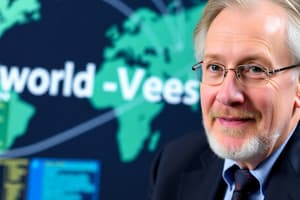Podcast
Questions and Answers
Which of the following best describes the significance of Tim Berners-Lee's decision to make the World Wide Web available for free?
Which of the following best describes the significance of Tim Berners-Lee's decision to make the World Wide Web available for free?
- It primarily benefited CERN by attracting more researchers and funding to the organization.
- It allowed him to maintain complete control over the development and standardization of web technologies.
- It ensured that only a select group of researchers and academics could contribute to the web's evolution.
- It accelerated the adoption and expansion of the web by removing financial barriers to entry. (correct)
What was the paramount impact of Arpanet’s establishment in 1963, commissioned by J.C.R. Licklider?
What was the paramount impact of Arpanet’s establishment in 1963, commissioned by J.C.R. Licklider?
- The immediate commercialization of networking technology.
- The exclusive use of the internet for government communication.
- The facilitation of interconnected research computers, prefiguring the internet. (correct)
- The standardization of secure online transactions.
How did the creation of HTML and HTTP contribute to the proliferation of the World Wide Web?
How did the creation of HTML and HTTP contribute to the proliferation of the World Wide Web?
- They established a proprietary system that required licensing fees for web development.
- They created a complex system that only large corporations could afford to implement.
- They provided standardized protocols for coding and communicating, making web development accessible and universal. (correct)
- They limited access to the web to only those with advanced programming skills.
What role did the World Wide Web Consortium (W3C), founded by Berners-Lee, play in the evolution of the internet?
What role did the World Wide Web Consortium (W3C), founded by Berners-Lee, play in the evolution of the internet?
What was the principal motivation behind Berners-Lee's advocacy for a "fair, democratic, and truly 'World Wide' Web?"
What was the principal motivation behind Berners-Lee's advocacy for a "fair, democratic, and truly 'World Wide' Web?"
What critical function did the establishment of data transfer procedures in 1978 and their enforcement in 1983 serve in the evolution of the internet?
What critical function did the establishment of data transfer procedures in 1978 and their enforcement in 1983 serve in the evolution of the internet?
Which of the following exemplifies the impact of the World Wide Web on global interaction and commerce?
Which of the following exemplifies the impact of the World Wide Web on global interaction and commerce?
What was the primary goal of Tim Berners-Lee's initial webpage published on August 6, 1991?
What was the primary goal of Tim Berners-Lee's initial webpage published on August 6, 1991?
Which of the following best describes the core problem Tim Berners-Lee aimed to solve with the invention of ENQUIRE?
Which of the following best describes the core problem Tim Berners-Lee aimed to solve with the invention of ENQUIRE?
Tim Berners-Lee's vision for the World Wide Web extended beyond just universal access. What potential threat to his original dream is highlighted?
Tim Berners-Lee's vision for the World Wide Web extended beyond just universal access. What potential threat to his original dream is highlighted?
How did Tim Berners-Lee contribute to the development of the internet beyond just creating the World Wide Web?
How did Tim Berners-Lee contribute to the development of the internet beyond just creating the World Wide Web?
Which of the following reflects the most significant impact of Tim Berners-Lee's decision to offer the World Wide Web to the public for free?
Which of the following reflects the most significant impact of Tim Berners-Lee's decision to offer the World Wide Web to the public for free?
Consider Tim Berners-Lee's early work on ENQUIRE and his later proposal for the World Wide Web. What fundamental concept links these two projects?
Consider Tim Berners-Lee's early work on ENQUIRE and his later proposal for the World Wide Web. What fundamental concept links these two projects?
Tim Berners-Lee's parents worked on the Mark I computer. What significance does this have in understanding his career?
Tim Berners-Lee's parents worked on the Mark I computer. What significance does this have in understanding his career?
What was unique about the way Tim Berners-Lee built his first computer?
What was unique about the way Tim Berners-Lee built his first computer?
What underlying principle was threatened by growing political and commercial interests online?
What underlying principle was threatened by growing political and commercial interests online?
Flashcards
Tim Berners-Lee
Tim Berners-Lee
British computer scientist, inventor of the World Wide Web.
ENQUIRE
ENQUIRE
A program to connect CERN academics and their projects, created in 1980.
"Information Management: A Proposal"
"Information Management: A Proposal"
A proposal outlining a linked hypertext data system, submitted in 1989.
World Wide Web
World Wide Web
Signup and view all the flashcards
2004
2004
Signup and view all the flashcards
1980
1980
Signup and view all the flashcards
Internet
Internet
Signup and view all the flashcards
World Wide Web proposal (1989)
World Wide Web proposal (1989)
Signup and view all the flashcards
Browser
Browser
Signup and view all the flashcards
Open access
Open access
Signup and view all the flashcards
HTML (Hypertext Markup Language)
HTML (Hypertext Markup Language)
Signup and view all the flashcards
HTTP (Hypertext Transfer Protocol)
HTTP (Hypertext Transfer Protocol)
Signup and view all the flashcards
World Wide Web Consortium (W3C)
World Wide Web Consortium (W3C)
Signup and view all the flashcards
August 6, 1991
August 6, 1991
Signup and view all the flashcards
J.C.R. Licklider
J.C.R. Licklider
Signup and view all the flashcards
Arpanet
Arpanet
Signup and view all the flashcards
Study Notes
- Tim Berners-Lee, a British computer scientist, invented the World Wide Web.
- The World Wide Web is a multimedia library, workplace, shopping center, and social space accessible via the internet.
- Berners-Lee set up the World Wide Web in 1991.
- Berners-Lee made his invention available to the world for free.
Early Programming
- 1980: Berners-Lee wrote ENQUIRE, a computer program designed to connect CERN academics and their projects.
Landmark Paper
- 1989: Berners-Lee submitted "Information Management: A Proposal," which outlined a linked hypertext data system.
World Wide Web Launch
- 1991: The World Wide Web was launched at CERN.
- The launch included HTML (hypertext markup language), HTTP (hypertext transfer protocol), and the first browser.
Knighthood
- 2004: Queen Elizabeth II knighted Berners-Lee in recognition of his contributions to the global development of the internet.
Early Life and Education
- Born in London in 1955, Berners-Lee showed an early interest in computers.
- His parents worked as computer programmers at Ferranti, a UK company.
- Ferranti produced the Mark I, the world’s first general-purpose business computer.
- In 1973, Berners-Lee attended Oxford University to study physics.
- While at Oxford, he built his first homemade computer using a second-hand television, logic gates, and a processor.
Career
- After university, Berners-Lee worked as a software engineer for British companies.
- In 1980, he joined CERN (Europe’s nuclear research lab) as a consultant.
- CERN is known as the home of the Large Hadron Collider.
- Berners-Lee conceived the idea that would transform global communication while addressing the needs of CERN's multilingual staff.
ENQUIRE Program
- In 1980, Berners-Lee created ENQUIRE to store information and track connections between people and projects at CERN.
- ENQUIRE demonstrated that documents collected on the internet could be accessed by anyone with a computer.
- The internet was a physical network of computers that had been growing since its origins in 1963.
Vision
- Berners-Lee's vision was "universal access to a large universe of documents".
- Growing political and commercial interests online that threaten his dream of an open, democratic Web.
World Wide Web Proposal
- The internet was largely promoted by academics and the US Department of Defense.
- The internet had limited public access initially.
- Berners-Lee returned to CERN as a fellow in 1984.
- At that time, CERN was the largest internet node in Europe.
- In 1989, Berners-Lee proposed the World Wide Web.
- The World Wide Web would enable users to access information via the internet using a "browser."
Open Access
- Berners-Lee encouraged CERN to make the World Wide Web available to the world for free by putting it into the public domain.
First Webpage
- Berners-Lee published a manifesto with instructions for programmers to build their own websites.
- The document was effectively the first webpage.
- It outlined two standards: HTML (hypertext markup language) and HTTP (hypertext transfer protocol).
- HTML is a standard way of coding webpages, enabling any computer to display them.
- HTTP is a language enabling web browsers to communicate with web servers storing websites in HTML.
Web Growth
- The simplicity of HTML and HTTP contributed to the rapid adoption of Berners-Lee’s invention.
- Secure, easy-to-use web browsers also contributed to the rapid adoption of the World Wide Web.
- By the mid-1990s, millions of users, including home users, universities, scientists, governments, and businesses, were using the World Wide Web.
- They interacted, created content, sold products, and shopped online.
World Wide Web Consortium
- In 1994, Berners-Lee established the World Wide Web Consortium (W3C).
- The W3C continues to develop the Web’s open standards.
- Berners-Lee has advocated for a fair, democratic, and truly “World Wide” Web that benefits everyone politically, socially, and economically.
Key Dates and Figures
- The first ever webpage was published on August 6, 1991.
- There are now more than 4 billion internet users.
- Berners-Lee chose not to receive royalties from the Web.
J.C.R. Licklider
- J.C.R. Licklider was an early champion for computer power.
- He was head of Information Processing at the US government’s Advanced Research Projects Agency (ARPA) starting in 1962.
- Licklider (1915–1990) was an early force behind computer technology.
- In 1963, he commissioned Arpanet—the Intergalactic Computer Network—which connected research computers.
- Procedures for transferring data were fixed by 1978 and became compulsory in 1983, effectively creating the internet.
Studying That Suits You
Use AI to generate personalized quizzes and flashcards to suit your learning preferences.





